physics term2
5.0(1)
5.0(1)
Card Sorting
1/49
Earn XP
Description and Tags
Study Analytics
Name | Mastery | Learn | Test | Matching | Spaced |
|---|
No study sessions yet.
50 Terms
1
New cards
wave
A disturbance or vibration carrying energy through a medium
2
New cards
amplitude
Maximum distance any point in a wave moves from its rest position.
3
New cards
wavelength
distance between 2 corresponding points of a wave; a full cycle. (compression to compression, crest to crest etc)
4
New cards
wave velocity(m/s)=
frequency(Hz) x wavelength(m) or v=λf
5
New cards

strobe light method
A method of finding the wave length.
1)turn on the machine and strobe light.
2)adjust the frequency of the strobe until it appears still.
3)measure the distance covered by 10 strobes with a cm ruler for accuracy.
4)divide the result by 10 to find the average wavelength.
5)you can multiply wavelength and frequency to find wave velocity.
1)turn on the machine and strobe light.
2)adjust the frequency of the strobe until it appears still.
3)measure the distance covered by 10 strobes with a cm ruler for accuracy.
4)divide the result by 10 to find the average wavelength.
5)you can multiply wavelength and frequency to find wave velocity.
6
New cards
frequency
Number of complete waves/cycles passing a point per second
7
New cards
period
the number of seconds it takes for one full cycle. period=1÷frequency.
8
New cards
crest
Highest point of a wave
9
New cards
trough
Lowest point of a wave
10
New cards
medium
The material wave travels through
11
New cards
mechanical wave
Waves that are caused by vibration.
12
New cards
transverse wave
A mechanical wave in which the particles of the medium vibrate at right angles (perpendicular) to the direction that the wave travels.
Transverse waves transport energy without transporting matter.
Does not need particles to carry the vibration.
Transverse waves transport energy without transporting matter.
Does not need particles to carry the vibration.
13
New cards
longitudinal wave
.A mechanical wave in which particles of the medium vibrate in the same direction that the wave travels.
(back and forth, parallel to the wave direction)
Longitudinal waves transport energy without transporting matter.
Needs particles to carry the vibration.
(back and forth, parallel to the wave direction)
Longitudinal waves transport energy without transporting matter.
Needs particles to carry the vibration.
14
New cards
rarefaction
A decrease in density and pressure in a medium, such as air, especially when caused by the passage of a wave, such as a sound wave.
(low pressure, fewer particles)
(low pressure, fewer particles)
15
New cards
compression
A force that tends to shorten or squeeze something, decreasing its volume. ( high pressure, lots of particles)
16
New cards
sound waves
Transfer of energy from a vibrating object in longitudinal waves that travel through matter and are perceived by ears.
It travels in a series of compressions and rarefactions .
The speed depends on the medium through which it is travelling.
It travels in a series of compressions and rarefactions .
The speed depends on the medium through which it is travelling.
17
New cards
echoes
reflected sound waves. (sound waves that hit a hard fat surface).
18
New cards
superposition
* The change from one wave to two.
* When two waves meet, they either add together or cancel each other out. This change of two waves into one wave is called
* When two waves meet, they either add together or cancel each other out. This change of two waves into one wave is called
19
New cards
speed=
distance / time
20
New cards
clap- echoes method
A method of measuring the speed of sound.
1)You stand a long distance from a wall, hit 2 wooden blocks together, start the stopwatch and listen for the echo and then stop the stopwatch.
2)One way to reduce timing errors in this method is to clap in time to the echoes 10 times.
3)This means that the time between each clap is the journey time for the sound.
4)You then measure the time for 10 claps.
5)This time will then be applied to the formula to find speed
1)You stand a long distance from a wall, hit 2 wooden blocks together, start the stopwatch and listen for the echo and then stop the stopwatch.
2)One way to reduce timing errors in this method is to clap in time to the echoes 10 times.
3)This means that the time between each clap is the journey time for the sound.
4)You then measure the time for 10 claps.
5)This time will then be applied to the formula to find speed
21
New cards
velocity
the speed of something
22
New cards
wavelength of a soundwave…
changes, it gets longer when it speeds up, and shorter when it slows down
23
New cards
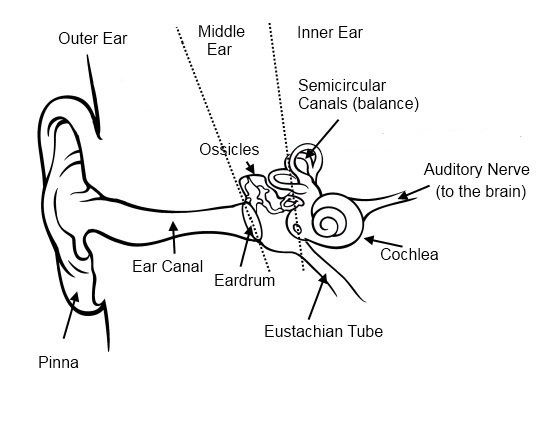
eardrums
the part of your ear that receives soundwaves and vibrates.
It passes on the vibrations to the ossicles.
It passes on the vibrations to the ossicles.
24
New cards
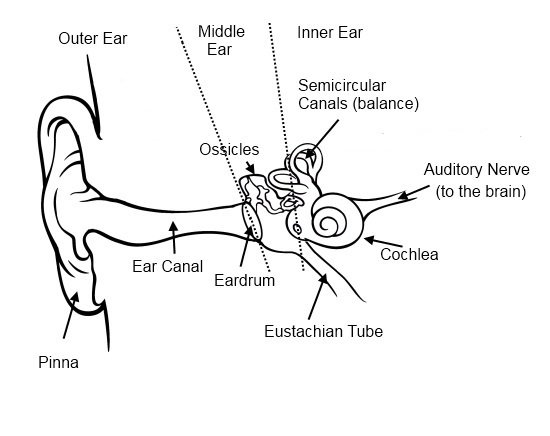
ossicles
tiny bones in your middle ear that pass on sound wave vibration through the semi-circular canals and into the cochlea
25
New cards
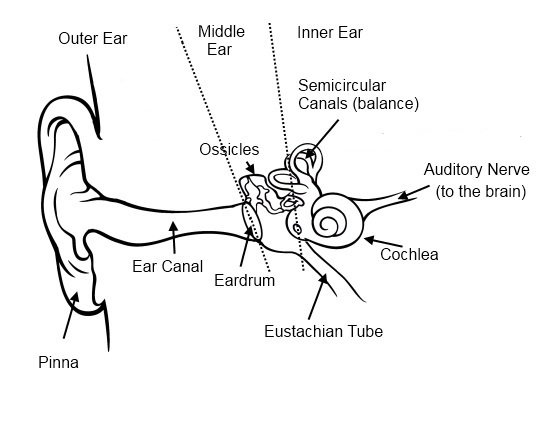
cochlea
a spiral shaped organ in the middle ear that turns the sound vibrations into electrical signals which gets sent to your brain
the brain then interperates the signals as sound.
the brain then interperates the signals as sound.
26
New cards
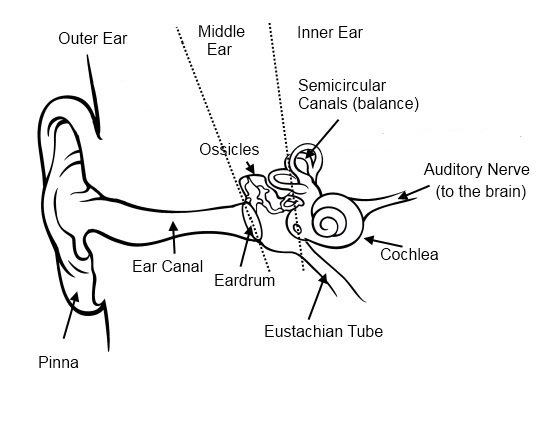
auditory nerve
a nerve carrying and connecting electrical signals from the inner ear to the brain.
the brain then interprets the signals as pitches and volumes depending on intensity and frequency.
(example, high frequency=high pitch)
the brain then interprets the signals as pitches and volumes depending on intensity and frequency.
(example, high frequency=high pitch)
27
New cards
audition
human hearing, it is limited by the size and shape of the eardrums.
older people need sound to be louder to hear because of the wear and tear or the cochlea and auditory nerve over time.
older people need sound to be louder to hear because of the wear and tear or the cochlea and auditory nerve over time.
28
New cards
ultrasound waves
sound with a frequency greater than 20,000 Hz and are used to form images of anything in the body that is not surrounded by bone.
(developing foetus’ , liver, kidney etc)
(developing foetus’ , liver, kidney etc)
29
New cards
absorption
when after meeting a boundary, the energy being transferred by a wave is taken into an energy store of a material.
(this how a microwave works)
(this how a microwave works)
30
New cards
transmission
when meeting a boundary, a wave keeps on travelling through the new material often at a different speed/velocity which can lead to refraction
31
New cards
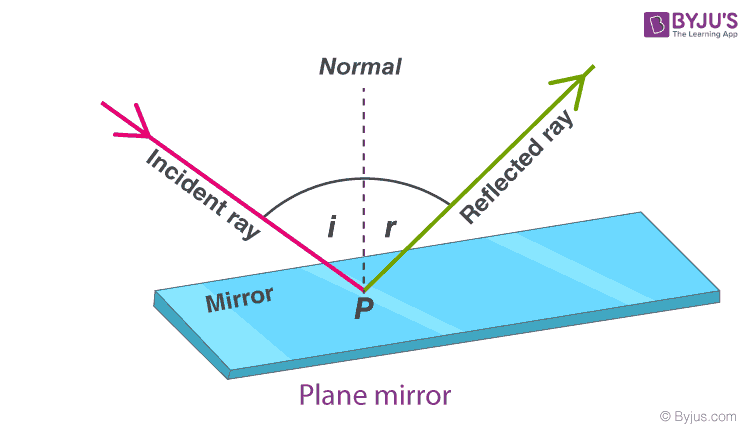
reflection
when after meeting a boundary, an incoming ray is sent ‘back’ from the new material.
angle of incidence= angle of reflection ALWAYS
angle of incidence= angle of reflection ALWAYS
32
New cards
normal
an imaginary line that is at a right-angle 90° to the surface at the point the light hits it
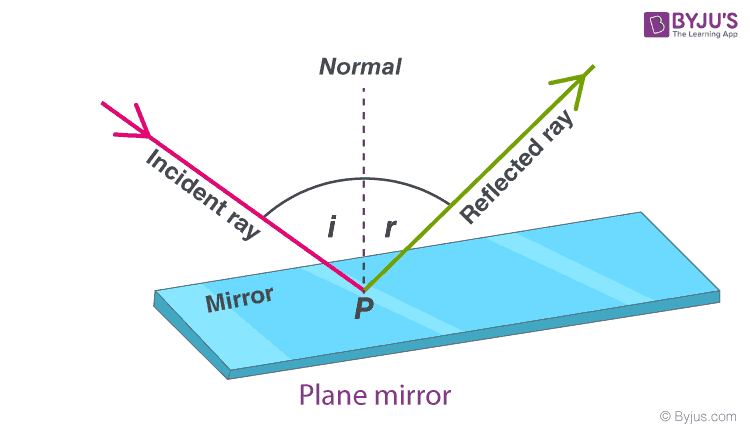
33
New cards
reflection of visible light
What allows us to see thing; light bounces off of objects and into our eyes.
34
New cards
scattering
light rays reflect off of a rough surface (paper) in all different directions.
each ray hits surface at a different angle and reflect at that same angle.
each ray hits surface at a different angle and reflect at that same angle.
35
New cards
specular reflection
light rays reflect off of a smooth surface in all the same direction giving a clear reflection
36
New cards
white light
a mixture of all different colours of light (red, yellow ,green ,blue ,indigo, violet)
each colour has a different wave length.
each colour has a different wave length.
37
New cards
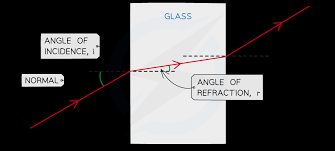
refraction
the change in direction of a wave passing from one medium to another caused by its change in speed.
38
New cards
the wave bends towards the normal
if the wave slows down
39
New cards
the wave bends away from the normal.
if the wave speeds up
40
New cards

triangular prisms disperse white light
each colour has a slightly different wavelength, so they refract at different angles which shows a rainbow.
\
each colour has a slightly different wavelength, so they refract at different angles which shows a rainbow.
\
triangular prism experiment
41
New cards
transverse waves that are vibrations of electric and magnetic fields
* they can all transfer energy as **radiation** from the source of the waves to an absorber
* can travel through a **vacuum** such as in space
* travel at the same speed through a vacuum or the air
* they can all transfer energy as **radiation** from the source of the waves to an absorber
* can travel through a **vacuum** such as in space
* travel at the same speed through a vacuum or the air
electromagnetic waves
42
New cards
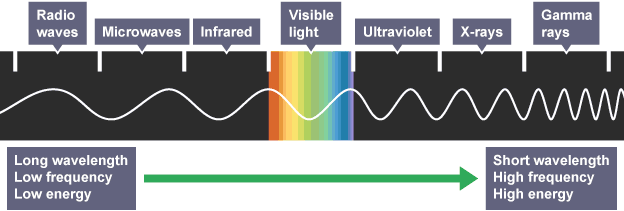
The complete range of frequencies of electromagnetic waves from the lowest to the highest in order
radio, infrared, visible light, ultraviolet, X-ray, and gamma ray waves
radio, infrared, visible light, ultraviolet, X-ray, and gamma ray waves
electromagnetic spectrum
43
New cards
an EM wave that has the longest wavelength and lowest frequency of the spectrum.
Is used for communication
can be transmitted through the body without being absorbed.
Is used for communication
can be transmitted through the body without being absorbed.
an EM wave that has the longest wavelength and lowest frequency of the spectrum.
Is used for communication
can be transmitted through the body without being absorbed.
Is used for communication
can be transmitted through the body without being absorbed.
44
New cards
microwaves
an EM wave that has the second longest wavelength an second lowest frequency of the EM spectrum
It is used for communication and cooking
The wavelength of this wave can be absorbed, causing the heating of cells which can be dangerous
It is used for communication and cooking
The wavelength of this wave can be absorbed, causing the heating of cells which can be dangerous
45
New cards
infa-red
an EM wave that has the 3rd longest wavelength and 3rd lowest frequency.
It is used increase or monitor temperature
it is mostly reflected or absorbed by the skin, causing some heat.
This wave can cause burns if skin gets to hot.
It is used increase or monitor temperature
it is mostly reflected or absorbed by the skin, causing some heat.
This wave can cause burns if skin gets to hot.
46
New cards
visible light
an EM wave which is in the middle of the spectrum and the only wave we can see.
It is used for fibre optics and as a light source
It is mostly reflected or absorbed by the skin but is also used as a light source or be concentrated to make a laser
It can damage the retina of your eye.
It is used for fibre optics and as a light source
It is mostly reflected or absorbed by the skin but is also used as a light source or be concentrated to make a laser
It can damage the retina of your eye.
47
New cards
ultra-violet
an EM wave which has the 3rd shortest wavelength and 3rd highest frequency of the EM spectrum.
It is used in fluorescent lamps
it is mostly absorbed by skin, but has a higher frequency meaning it transfers more energy causing more damage.
could lead to skin cancer, tissue damage, genetic mutations and radiation illness
It is used in fluorescent lamps
it is mostly absorbed by skin, but has a higher frequency meaning it transfers more energy causing more damage.
could lead to skin cancer, tissue damage, genetic mutations and radiation illness
48
New cards
ionising radiation
When waves that transfer a lot of energy enter living cells, it collides with atoms, knocking of electrons.
49
New cards
x-rays
an EM wave that has the second shortest wavelength and second highest frequency.
it is used to observe the bones and has a very high frequency ,meaning it transfers a lot of energy.
it is also ionising , can cause skin cancer, genetic mutations and can pass through the skin and be absorbed by deeper tissues.
it is used to observe the bones and has a very high frequency ,meaning it transfers a lot of energy.
it is also ionising , can cause skin cancer, genetic mutations and can pass through the skin and be absorbed by deeper tissues.
50
New cards
gamma rays
an EM wave which has the shortest wavelength and the highest frequency
It is used to sterilised medical instruments and cancer treatment
It can cause radiation illness, genetic mutations and skin cancer
\
It is used to sterilised medical instruments and cancer treatment
It can cause radiation illness, genetic mutations and skin cancer
\